Multiscenario Simulation of Land-Use Change in Hubei Province, China Based on the Markov-FLUS Model
Abstract
1. Introduction
- Historical land use data from 2000 to 2015 and 18 driving factors, including 10 points-of-interest data, were used to simulate future land use patterns in Hubei Province, China.
- The improved model simulated and analyzed four different future land use scenarios, providing valuable insights for decision making on sustainable land use and planning management in Hubei Province, China.
2. Materials and Methodology
2.1. Case Overview
2.2. Research Design
2.3. Data and Preprocessing
2.4. Methodology
2.4.1. Principles of the Markov-FLUS Model
2.4.2. Drivers of Land-Use Change
2.4.3. Model Accuracy Verification
2.5. Multiple Scenario Simulations
2.5.1. Design of Multiple Scenario Simulations
- The natural development scenario, also known as the recent trends scenario, is constructed based on the trajectory of past and current development in Hubei Province. The current trends for economic and population development and technological innovation are assumed to remain continually consistent. In this scenario, there is no human interference or restrictions on land use development, and it follows the natural changes in land use based on historical characteristics of land-use change and natural socioeconomic development factors, with transition probabilities maintaining the level between 2000 and 2020. In other words, the recent trends scenario assumes a continuation of historical patterns of land change.
- The economic priority scenario, which aims to maximize socioeconomic benefits, assumes that cities become attractive destinations due to rapid regional economic growth and technological innovation. The continuous rapid growth of the population and economy comes at the expense of natural resources (with a growth rate of approximately 0.9% to 8%), leading to drastic land-use changes. In this scenario, economic development is prioritized and requires the rapid expansion of built-up land such as cities and roads, which are important signs of economic development. In this model, we increase the cost of conversion from built-up land to other land and reduce the probability of transfer from living space to ecological space.
- The ecological protection scenario focuses on protecting ecological land, with a cultivated land area of no less than that of the planned cultivated land retention and medium- to high-yield cultivated land area in 2020. The forest area is no less than the planned area in 2020. The area of urban land, rural residential areas, and other construction land does not exceed the planned area in 2020. The ecological protection red-line area is the restricted development zone. In other words, the ecological protection scenario refers to strengthening forests, grassland, water, and other ecological lands while weakening the expansion capacity of the other land types.
- The cultivated land protection scenario, which aims to simulate the impact and environmental effects of cultivated land protection policies and land reclamation activities, takes the key cultivated land protection areas (basic farmland protection areas) as the restricted development area, with a cultivated land area of no less than that of the planned cultivated land retention and medium- to high-yield cultivated land area in 2020. The area of urban land, rural residential areas, and other construction land does not exceed the planned area in 2020. The probability of cultivated land being converted to urban land, rural residential areas, and other construction land is reduced, while the probability of grassland, urban land, rural residential areas, and unused land being converted to cultivated land is increased.
2.5.2. Neighborhood Factors
2.5.3. Conversion Costs and Restricted Change Area Settings
3. Results and Discussion
3.1. Land-Use Changes from 2000 to 2020
3.2. Scenario 1: Natural Development
3.3. Scenario 2: Economic Priority
3.4. Scenario 3: Ecological Protection
3.5. Scenario 4: Cultivated Land Protection
4. Limitations and Future Work
5. Conclusions
Author Contributions
Funding
Data Availability Statement
Acknowledgments
Conflicts of Interest
References
- Lin, J.; He, P.; Yang, L.; He, X.; Lu, S.; Liu, D. Predicting Future Urban Waterlogging-Prone Areas by Coupling the Maximum Entropy and FLUS Model. Sustain. Cities Soc. 2022, 80, 103812. [Google Scholar] [CrossRef]
- Yang, K.; Hou, H.; Li, Y.; Chen, Y.; Wang, L.; Wang, P.; Hu, T. Future Urban Waterlogging Simulation Based on LULC Forecast Model: A Case Study in Haining City, China. Sustain. Cities Soc. 2022, 87, 104167. [Google Scholar] [CrossRef]
- Turner, B.L.; Skole, D.; Sanderson, S.; Fischer, G.; Fresco, L.; Leemans, R. Land-Use and Land-Cover Change: Science/Research Plan. Scanning Electron Microsc. 1995. Available online: https://asu.pure.elsevier.com/en/publications/land-use-and-land-cover-change-scienceresearch-plan-2 (accessed on 21 November 2022).
- Verburg, P.H.; Alexander, P.; Evans, T.; Magliocca, N.R.; Malek, Z.; Rounsevell, M.D.; van Vliet, J. Beyond Land Cover Change: Towards a New Generation of Land Use Models. Curr. Opin. Environ. Sustain. 2019, 38, 77–85. [Google Scholar] [CrossRef]
- Wang, J.; Bretz, M.; Dewan, M.A.A.; Delavar, M.A. Machine Learning in Modelling Land-Use and Land Cover-Change (LULCC): Current Status, Challenges and Prospects. Sci. Total Environ. 2022, 822, 153559. [Google Scholar] [CrossRef] [PubMed]
- Long, H.; Qu, Y. Land Use Transitions and Land Management: A Mutual Feedback Perspective. Land Use Policy 2018, 74, 111–120. [Google Scholar] [CrossRef]
- Wang, J.; Lin, Y.; Glendinning, A.; Xu, Y. Land-Use Changes and Land Policies Evolution in China’s Urbanization Processes. Land Use Policy 2018, 75, 375–387. [Google Scholar] [CrossRef]
- Carranza-García, M.; García-Gutiérrez, J.; Riquelme, J.C. A Framework for Evaluating Land Use and Land Cover Classification Using Convolutional Neural Networks. Remote Sens. 2019, 11, 274. [Google Scholar] [CrossRef]
- Veldkamp, A.; Lambin, E.F. Predicting Land-Use Change. Agric. Ecosyst. Environ. 2001, 85, 1–6. [Google Scholar] [CrossRef]
- Noszczyk, T. A Review of Approaches to Land Use Changes Modeling. Hum. Ecol. Risk Assess. Int. J. 2019, 25, 1377–1405. [Google Scholar] [CrossRef]
- Chang, Y.; Hou, K.; Li, X.; Zhang, Y.; Chen, P. Review of Land Use and Land Cover Change Research Progress. IOP Conf. Ser. Earth Environ. Sci. 2018, 113, 012087. [Google Scholar] [CrossRef]
- Ren, Y.; Lü, Y.; Comber, A.; Fu, B.; Harris, P.; Wu, L. Spatially Explicit Simulation of Land Use/Land Cover Changes: Current Coverage and Future Prospects. Earth-Sci. Rev. 2019, 190, 398–415. [Google Scholar] [CrossRef]
- Mor, B.; Garhwal, S.; Kumar, A. A Systematic Review of Hidden Markov Models and Their Applications. Arch. Computat. Methods Eng. 2021, 28, 1429–1448. [Google Scholar] [CrossRef]
- Yang, T.; Liu, J.; Chen, Q. Assessment of Plain River Ecosystem Function Based on Improved Gray System Model and Analytic Hierarchy Process for the Fuyang River, Haihe River Basin, China. Ecol. Model. 2013, 268, 37–47. [Google Scholar] [CrossRef]
- Chen, Z.; Huang, M.; Zhu, D.; Altan, O. Integrating Remote Sensing and a Markov-FLUS Model to Simulate Future Land Use Changes in Hokkaido, Japan. Remote Sens. 2021, 13, 2621. [Google Scholar] [CrossRef]
- Sedarati, P.; Santos, S.; Pintassilgo, P. System Dynamics in Tourism Planning and Development. Tour. Plan. Dev. 2019, 16, 256–280. [Google Scholar] [CrossRef]
- Gilpin, W. Cellular Automata as Convolutional Neural Networks. Phys. Rev. E 2019, 100, 032402. [Google Scholar] [CrossRef] [PubMed]
- Dorri, A.; Kanhere, S.S.; Jurdak, R. Multi-Agent Systems: A Survey. IEEE Access 2018, 6, 28573–28593. [Google Scholar] [CrossRef]
- Gao, Z.; Gao, W.; Jie, Z. The Study of Urban Sprawl and Simulation Based on Remote Sensing and CLUS Model. In Proceedings of the Remote Sensing and Modeling of Ecosystems for Sustainability IV, San Diego, CA, USA, 22 October 2007; SPIE: Bellingham, DC, USA; Volume 6679, pp. 398–403. [Google Scholar]
- Meyfroidt, P.; Lambin, E.F.; Erb, K.-H.; Hertel, T.W. Globalization of Land Use: Distant Drivers of Land Change and Geographic Displacement of Land Use. Curr. Opin. Environ. Sustain. 2013, 5, 438–444. [Google Scholar] [CrossRef]
- Yeh, A.G.-O.; Li, X. A Constrained CA Model for the Simulation and Planning of Sustainable Urban Forms by Using GIS. Environ. Plan. B Plan. Des. 2001, 28, 733–753. [Google Scholar] [CrossRef]
- Sang, L.; Zhang, C.; Yang, J.; Zhu, D.; Yun, W. Simulation of Land Use Spatial Pattern of Towns and Villages Based on CA–Markov Model. Math. Comput. Model. 2011, 54, 938–943. [Google Scholar] [CrossRef]
- Liang, X.; Liu, X.; Li, X.; Chen, Y.; Tian, H.; Yao, Y. Delineating Multi-Scenario Urban Growth Boundaries with a CA-Based FLUS Model and Morphological Method. Landsc. Urban Plan. 2018, 177, 47–63. [Google Scholar] [CrossRef]
- Clarke, K.C. Mapping and Modelling Land Use Change: An Application of the SLEUTH Model. In Landscape Analysis and Visualisation: Spatial Models for Natural Resource Management and Planning; Pettit, C., Cartwright, W., Bishop, I., Lowell, K., Pullar, D., Duncan, D., Eds.; Lecture Notes in Geoinformation and Cartography; Springer: Berlin/Heidelberg, Germany, 2008; pp. 353–366. ISBN 978-3-540-69168-6. [Google Scholar]
- Feng, H.-H.; Liu, H.-P.; Lü, Y. Scenario Prediction and Analysis of Urban Growth Using SLEUTH Model. Pedosphere 2012, 22, 206–216. [Google Scholar] [CrossRef]
- Aydın, A.; Eker, R. Future Land Use/Land Cover Scenarios Considering Natural Hazards Using Dyna-CLUE in Uzungöl Nature Conservation Area (Trabzon-NE Türkiye). Nat. Hazards 2022, 114, 2683–2707. [Google Scholar] [CrossRef]
- Gaur, S.; Singh, R. A Comprehensive Review on Land Use/Land Cover (LULC) Change Modeling for Urban Development: Current Status and Future Prospects. Sustainability 2023, 15, 903. [Google Scholar] [CrossRef]
- Gomes, E.; Inácio, M.; Bogdzevič, K.; Kalinauskas, M.; Karnauskaitė, D.; Pereira, P. Future Land-Use Changes and Its Impacts on Terrestrial Ecosystem Services: A Review. Sci. Total Environ. 2021, 781, 146716. [Google Scholar] [CrossRef]
- Rahnama, M.R. Forecasting Land-Use Changes in Mashhad Metropolitan Area Using Cellular Automata and Markov Chain Model for 2016–2030. Sustain. Cities Soc. 2021, 64, 102548. [Google Scholar] [CrossRef]
- Khwarahm, N.R.; Qader, S.; Ararat, K.; Fadhil Al-Quraishi, A.M. Predicting and Mapping Land Cover/Land Use Changes in Erbil /Iraq Using CA-Markov Synergy Model. Earth Sci. Inform. 2021, 14, 393–406. [Google Scholar] [CrossRef]
- Cai, Y.; Zhang, F.; Duan, P.; Yung Jim, C.; Weng Chan, N.; Shi, J.; Liu, C.; Wang, J.; Bahtebay, J.; Ma, X. Vegetation Cover Changes in China Induced by Ecological Restoration-Protection Projects and Land-Use Changes from 2000 to 2020. CATENA 2022, 217, 106530. [Google Scholar] [CrossRef]
- Peng, K.; Jiang, W.; Ling, Z.; Hou, P.; Deng, Y. Evaluating the Potential Impacts of Land Use Changes on Ecosystem Service Value under Multiple Scenarios in Support of SDG Reporting: A Case Study of the Wuhan Urban Agglomeration. J. Clean. Prod. 2021, 307, 127321. [Google Scholar] [CrossRef]
- Xu, Q.; Guo, P.; Jin, M.; Qi, J. Multi-Scenario Landscape Ecological Risk Assessment Based on Markov–FLUS Composite Model. Geomat. Nat. Hazards Risk 2021, 12, 1449–1466. [Google Scholar] [CrossRef]
- Lin, Z.; Peng, S. Comparison of Multimodel Simulations of Land Use and Land Cover Change Considering Integrated Constraints—A Case Study of the Fuxian Lake Basin. Ecol. Indic. 2022, 142, 109254. [Google Scholar] [CrossRef]
- Liu, X.; Liang, X.; Li, X.; Xu, X.; Ou, J.; Chen, Y.; Li, S.; Wang, S.; Pei, F. A Future Land Use Simulation Model (FLUS) for Simulating Multiple Land Use Scenarios by Coupling Human and Natural Effects. Landsc. Urban Plan. 2017, 168, 94–116. [Google Scholar] [CrossRef]
- VERBURG, P.H.; SOEPBOER, W.; VELDKAMP, A.; LIMPIADA, R.; ESPALDON, V.; MASTURA, S.S.A. Modeling the Spatial Dynamics of Regional Land Use: The CLUE-S Model. Environ. Manag. 2002, 30, 391–405. [Google Scholar] [CrossRef]
- Ma, B.; Wang, X. What Is the Future of Ecological Space in Wuhan Metropolitan Area? A Multi-Scenario Simulation Based on Markov-FLUS. Ecol. Indic. 2022, 141, 109124. [Google Scholar] [CrossRef]
- Şenik, B.; Kaya, H.S. Landscape Sensitivity-Based Scenario Analysis Using Flus Model: A Case of Asarsuyu Watershed. Landscape Ecol. Eng. 2022, 18, 139–156. [Google Scholar] [CrossRef]
- Shao, Y.; Xiao, Y.; Sang, W. Land Use Trade-Offs and Synergies Based on Temporal and Spatial Patterns of Ecosystem Services in South China. Ecol. Indic. 2022, 143, 109335. [Google Scholar] [CrossRef]
- Cheng, L.; Brown, G.; Liu, Y.; Searle, G. An Evaluation of Contemporary China’s Land Use Policy–The Link Policy: A Case Study from Ezhou, Hubei Province. Land Use Policy 2020, 91, 104423. [Google Scholar] [CrossRef]
- Zhu, K.; Zhang, Y.; Wang, M.; Liu, H. The Ecological Compensation Mechanism in a cross-Regional Water Diversion Project Using Evolutionary Game Theory: The Case of the Hanjiang River Basin, China. Water 2022, 14, 1151. [Google Scholar] [CrossRef]
- Wang, Y.; Zhu, K.; Xiong, X.; Yin, J.; Yan, H.; Zhang, Y.; Liu, H. Assessment of the Ecological Compensation Standards for cross-Basin Water Diversion Projects from the Perspective of Main Headwater and Receiver Areas. Int. J. Environ. Res. Public Health 2023, 20, 717. [Google Scholar] [CrossRef] [PubMed]
- Zhou, Q.; Zhu, K.; Kang, L.; Dávid, L.D. Tea Culture Tourism Perception: A Study on the Harmony of Importance and Performance. Sustainability 2023, 15, 2838. [Google Scholar] [CrossRef]
- Jin, G.; Chen, K.; Liao, T.; Zhang, L.; Najmuddin, O. Measuring Ecosystem Services Based on Government Intentions for Future Land Use in Hubei Province: Implications for Sustainable Landscape Management. Landscape Ecol. 2021, 36, 2025–2042. [Google Scholar] [CrossRef]
- Zhu, K.; Liu, Q.; Xiong, X.; Zhang, Y.; Wang, M.; Liu, H. Carbon Footprint and Embodied Carbon Emission Transfer Network Obtained Using the Multi–Regional Input–Output Model and Social Network Analysis Method: A Case of the Hanjiang River Basin, China. Front. Ecol. Evol. 2022, 10, 733. [Google Scholar] [CrossRef]
- Zhu, K.; Zhou, Q.; Cheng, Y.; Zhang, Y.; Li, T.; Yan, X.; Alimov, A.; Farmanov, E.; Dávid, L.D. Regional Sustainability: Pressures and Responses of Tourism Economy and Ecological Environment in the Yangtze River Basin, China. Front. Ecol. Evol. 2023, 11, 168. [Google Scholar] [CrossRef]
- Yang, J.; Huang, X. The 30 m Annual Land Cover Dataset and Its Dynamics in China from 1990 to 2019. Earth Syst. Sci. Data 2021, 13, 3907–3925. [Google Scholar] [CrossRef]
- Huang, X.; Yang, J.; Wang, W.; Liu, Z. Mapping 10 m Global Impervious Surface Area (GISA-10m) Using Multi-Source Geospatial Data. Earth Syst. Sci. Data 2022, 14, 3649–3672. [Google Scholar] [CrossRef]
- Xu, Y.; Hu, X.; Gong, J.; Huang, X.; Li, J. Deep Learning Training with Unbalance Sample Distribution for Remote Sensing Image Segmentation. In Proceedings of the International Archives of the Photogrammetry, Remote Sensing and Spatial Information Sciences, Gottingen, Germany, 30 May 2022; Copernicus GmbH: Gottingen, Germany; Volume XLIII-B3-2022, pp. 223–228. [Google Scholar]
- Zhang, C.; Dong, J.; Ge, Q. Quantifying the Accuracies of Six 30-m Cropland Datasets over China: A Comparison and Evaluation Analysis. Comput. Electron. Agric. 2022, 197, 106946. [Google Scholar] [CrossRef]
- Zhao, Z.; Guan, D.; Du, C. Urban Growth Boundaries Delineation Coupling Ecological Constraints with a Growth-Driven Model for the Main Urban Area of Chongqing, China. GeoJournal 2020, 85, 1115–1131. [Google Scholar] [CrossRef]
- Xiang, S.; Wang, Y.; Deng, H.; Yang, C.; Wang, Z.; Gao, M. Response and Multi-Scenario Prediction of Carbon Storage to Land Use/Cover Change in the Main Urban Area of Chongqing, China. Ecol. Indic. 2022, 142, 109205. [Google Scholar] [CrossRef]
- Lin, W.; Sun, Y.; Nijhuis, S.; Wang, Z. Scenario-Based Flood Risk Assessment for Urbanizing Deltas Using Future Land-Use Simulation (FLUS): Guangzhou Metropolitan Area as a Case Study. Sci. Total Environ. 2020, 739, 139899. [Google Scholar] [CrossRef]
- Wang, Q.; Guan, Q.; Lin, J.; Luo, H.; Tan, Z.; Ma, Y. Simulating Land Use/Land Cover Change in an Arid Region with the Coupling Models. Ecol. Indic. 2021, 122, 107231. [Google Scholar] [CrossRef]
- Wang, R.; Murayama, Y.; Morimoto, T. Scenario Simulation Studies of Urban Development Using Remote Sensing and GIS: Review. Remote Sens. Appl. Soc. Environ. 2021, 22, 100474. [Google Scholar] [CrossRef]
- Tan, Z.; Guan, Q.; Lin, J.; Yang, L.; Luo, H.; Ma, Y.; Tian, J.; Wang, Q.; Wang, N. The Response and Simulation of Ecosystem Services Value to Land Use/Land Cover in an Oasis, Northwest China. Ecol. Indic. 2020, 118, 106711. [Google Scholar] [CrossRef]
- Zhao, J.; Shao, Z.; Xia, C.; Fang, K.; Chen, R.; Zhou, J. Ecosystem Services Assessment Based on Land Use Simulation: A Case Study in the Heihe River Basin, China. Ecol. Indic. 2022, 143, 109402. [Google Scholar] [CrossRef]
- Jiang, X.; Zhai, S.; Liu, H.; Chen, J.; Zhu, Y.; Wang, Z. Multi-Scenario Simulation of Production-Living-Ecological Space and Ecological Effects Based on Shared Socioeconomic Pathways in Zhengzhou, China. Ecol. Indic. 2022, 137, 108750. [Google Scholar] [CrossRef]
- Chen, B.; Xu, B.; Gong, P. Mapping Essential Urban Land Use Categories (EULUC) Using Geospatial Big Data: Progress, Challenges, and Opportunities. Big Earth Data 2021, 5, 410–441. [Google Scholar] [CrossRef]
- McClintock, B.T.; Langrock, R.; Gimenez, O.; Cam, E.; Borchers, D.L.; Glennie, R.; Patterson, T.A. Uncovering Ecological State Dynamics with Hidden Markov Models. Ecol. Lett. 2020, 23, 1878–1903. [Google Scholar] [CrossRef]
- Liu, C.; Deng, C.; Li, Z.; Liu, Y.; Wang, S. Optimization of Spatial Pattern of Land Use: Progress, Frontiers, and Prospects. Int. J. Environ. Res. Public Health 2022, 19, 5805. [Google Scholar] [CrossRef] [PubMed]
- Zhang, Z.; Hu, B.; Jiang, W.; Qiu, H. Identification and Scenario Prediction of Degree of Wetland Damage in Guangxi Based on the CA-Markov Model. Ecol. Indic. 2021, 127, 107764. [Google Scholar] [CrossRef]
- Busemeyer, J.R.; Kvam, P.D.; Pleskac, T.J. Comparison of Markov versus Quantum Dynamical Models of Human Decision Making. WIREs Cogn. Sci. 2020, 11, e1526. [Google Scholar] [CrossRef]
- Biao, Z.; Yunting, S.; Shuang, W. A Review on the Driving Mechanisms of Ecosystem Services Change. J. Resour. Ecol. 2022, 13, 68–79. [Google Scholar] [CrossRef]
- Wang, K.; Zhang, C.; Chen, H.; Yue, Y.; Zhang, W.; Zhang, M.; Qi, X.; Fu, Z. Karst Landscapes of China: Patterns, Ecosystem Processes and Services. Landscape Ecol. 2019, 34, 2743–2763. [Google Scholar] [CrossRef]
- Liu, L.; Wu, J. Scenario Analysis in Urban Ecosystem Services Research: Progress, Prospects, and Implications for Urban Planning and Management. Landsc. Urban Plan. 2022, 224, 104433. [Google Scholar] [CrossRef]
- Glennie, R.; Adam, T.; Leos-Barajas, V.; Michelot, T.; Photopoulou, T.; McClintock, B.T. Hidden Markov Models: Pitfalls and Opportunities in Ecology. Methods Ecol. Evol. 2023, 14, 43–56. [Google Scholar] [CrossRef]
- Khan, A.; Aslam, S.; Aurangzeb, K.; Alhussein, M.; Javaid, N. Multiscale Modeling in Smart Cities: A Survey on Applications, Current Trends, and Challenges. Sustain. Cities Soc. 2022, 78, 103517. [Google Scholar] [CrossRef]
- Yang, Q.; Liu, G.; Casazza, M.; Dumontet, S.; Yang, Z. Ecosystem Restoration Programs Challenges under Climate and Land Use Change. Sci. Total Environ. 2022, 807, 150527. [Google Scholar] [CrossRef] [PubMed]
- Aburas, M.M.; Ahamad, M.S.S.; Omar, N.Q. Spatio-Temporal Simulation and Prediction of Land-Use Change Using Conventional and Machine Learning Models: A Review. Environ. Monit. Assess. 2019, 191, 205. [Google Scholar] [CrossRef] [PubMed]
- Chughtai, A.H.; Abbasi, H.; Karas, I.R. A Review on Change Detection Method and Accuracy Assessment for Land Use Land Cover. Remote Sens. Appl. Soc. Environ. 2021, 22, 100482. [Google Scholar] [CrossRef]
- Froese, R.; Schilling, J. The Nexus of Climate Change, Land Use, and Conflicts. Curr. Clim. Change Rep. 2019, 5, 24–35. [Google Scholar] [CrossRef]
- Pătru-Stupariu, I.; Hossu, C.A.; Grădinaru, S.R.; Nita, A.; Stupariu, M.-S.; Huzui-Stoiculescu, A.; Gavrilidis, A.-A. A Review of Changes in Mountain Land Use and Ecosystem Services: From Theory to Practice. Land 2020, 9, 336. [Google Scholar] [CrossRef]
- Talukdar, S.; Singha, P.; Mahato, S.; Shahfahad; Pal, S.; Liou, Y.-A.; Rahman, A. Land-Use Land-Cover Classification by Machine Learning Classifiers for Satellite Observations—A Review. Remote Sens. 2020, 12, 1135. [Google Scholar] [CrossRef]
- Yang, H.; Hou, X.; Cao, J. Identifying the Driving Impact Factors on Water Yield Service in Mountainous Areas of the Beijing-Tianjin-Hebei Region in China. Remote Sens. 2023, 15, 727. [Google Scholar] [CrossRef]
- Zheng, J.; Wang, H.; Liu, B. Impact of the Long-Term Precipitation and Land Use Changes on Runoff Variations in a Humid Subtropical River Basin of China. J. Hydrol. Reg. Stud. 2022, 42, 101136. [Google Scholar] [CrossRef]
- Beillouin, D.; Cardinael, R.; Berre, D.; Boyer, A.; Corbeels, M.; Fallot, A.; Feder, F.; Demenois, J. A Global Overview of Studies about Land Management, Land-Use Change, and Climate Change Effects on Soil Organic Carbon. Glob. Change Biol. 2022, 28, 1690–1702. [Google Scholar] [CrossRef]
- Zhang, C.; Zhao, L.; Zhang, H.; Chen, M.; Fang, R.; Yao, Y.; Zhang, Q.; Wang, Q. Spatial-Temporal Characteristics of Carbon Emissions from Land Use Change in Yellow River Delta Region, China. Ecol. Indic. 2022, 136, 108623. [Google Scholar] [CrossRef]
- Allan, A.; Soltani, A.; Abdi, M.H.; Zarei, M. Driving Forces behind Land Use and Land Cover Change: A Systematic and Bibliometric Review. Land 2022, 11, 1222. [Google Scholar] [CrossRef]
- Yin, S.; Yi, Y.; Liu, Q.; Luo, Q.; Chen, K. A Review on Effects of Human Activities on Aquatic Organisms in the Yangtze River Basin since the 1950s. River 2022, 1, 104–119. [Google Scholar] [CrossRef]
- Zhao, L.; Peng, Z.-R. LandSys: An Agent-Based Cellular Automata Model of Land Use Change Developed for Transportation Analysis. J. Transp. Geogr. 2012, 25, 35–49. [Google Scholar] [CrossRef]
- Lin, J.; Li, X.; Wen, Y.; He, P. Modeling Urban Land-Use Changes Using a Landscape-Driven Patch-Based Cellular Automaton (LP-CA). Cities 2023, 132, 103906. [Google Scholar] [CrossRef]
- Molinero-Parejo, R.; Aguilera-Benavente, F.; Gómez-Delgado, M.; Shurupov, N. Combining a Land Parcel Cellular Automata (LP-CA) Model with Participatory Approaches in the Simulation of Disruptive Future Scenarios of Urban Land Use Change. Comput. Environ. Urban Syst. 2023, 99, 101895. [Google Scholar] [CrossRef]
- Chen, Y.; Liu, X.; Li, X. Calibrating a Land Parcel Cellular Automaton (LP-CA) for Urban Growth Simulation Based on Ensemble Learning. Int. J. Geogr. Inf. Sci. 2017, 31, 2480–2504. [Google Scholar] [CrossRef]
- Song, S.; Liu, Z.; He, C.; Lu, W. Evaluating the Effects of Urban Expansion on Natural Habitat Quality by Coupling Localized Shared Socioeconomic Pathways and the Land Use Scenario Dynamics-Urban Model. Ecol. Indic. 2020, 112, 106071. [Google Scholar] [CrossRef]
- Yang, Y.; Zhang, D.; Nan, Y.; Liu, Z.; Zheng, W. Modeling Urban Expansion in the Transnational Area of Changbai Mountain: A Scenario Analysis Based on the Zoned Land Use Scenario Dynamics-Urban Model. Sustain. Cities Soc. 2019, 50, 101622. [Google Scholar] [CrossRef]
- He, C.; Li, J.; Zhang, X.; Liu, Z.; Zhang, D. Will Rapid Urban Expansion in the Drylands of Northern China Continue: A Scenario Analysis Based on the Land Use Scenario Dynamics-Urban Model and the Shared Socioeconomic Pathways. J. Clean. Prod. 2017, 165, 57–69. [Google Scholar] [CrossRef]
- Hanoon, S.K.; Abdullah, D.A.F.; Shafri, D.H.Z.M.; Wayayok, D.A. Using Scenario Modelling for Adapting to Urbanization and Water Scarcity: Towards a Sustainable City in Semi-Arid Areas. Period. Eng. Nat. Sci. 2022, 10, 518–532. [Google Scholar] [CrossRef]
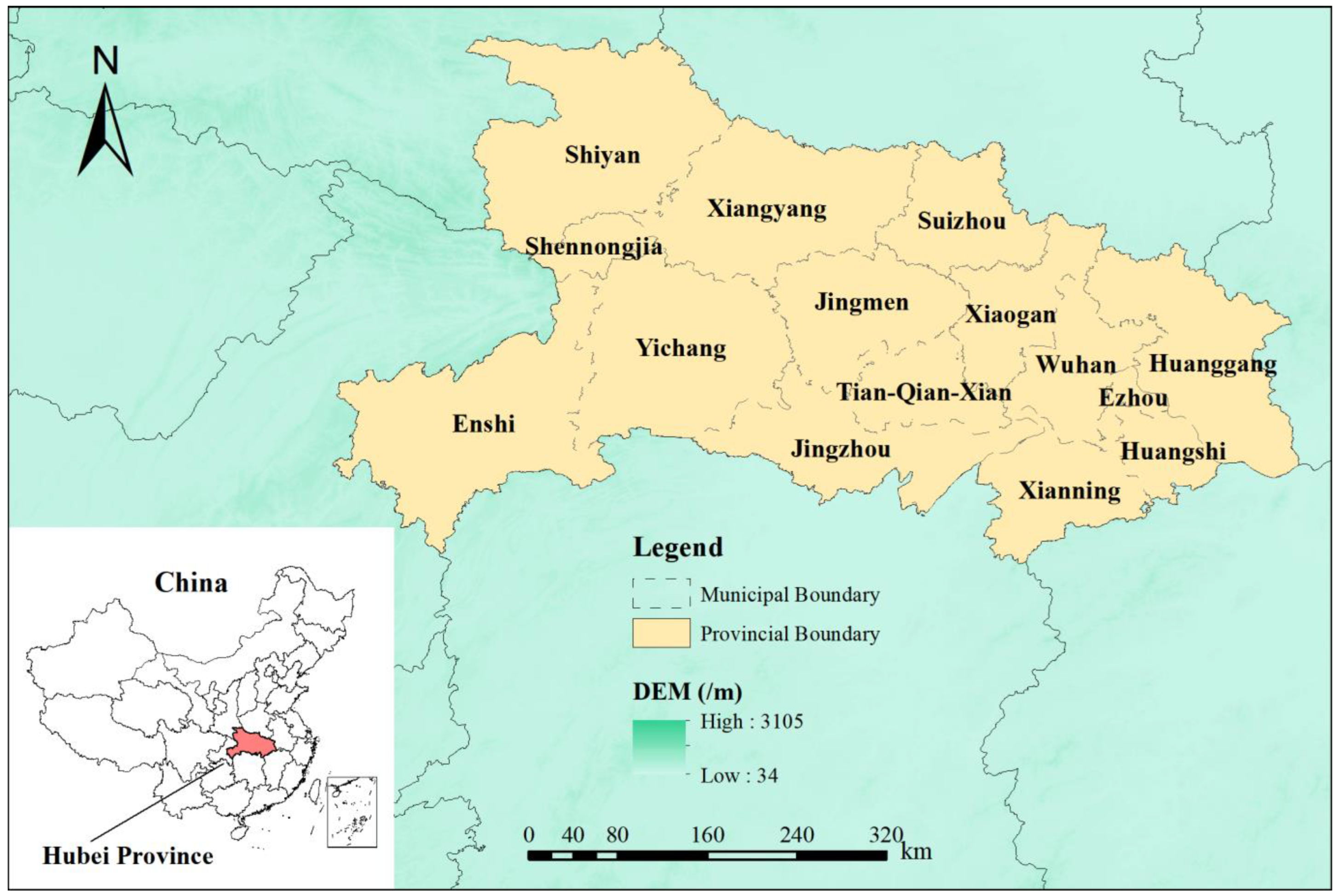
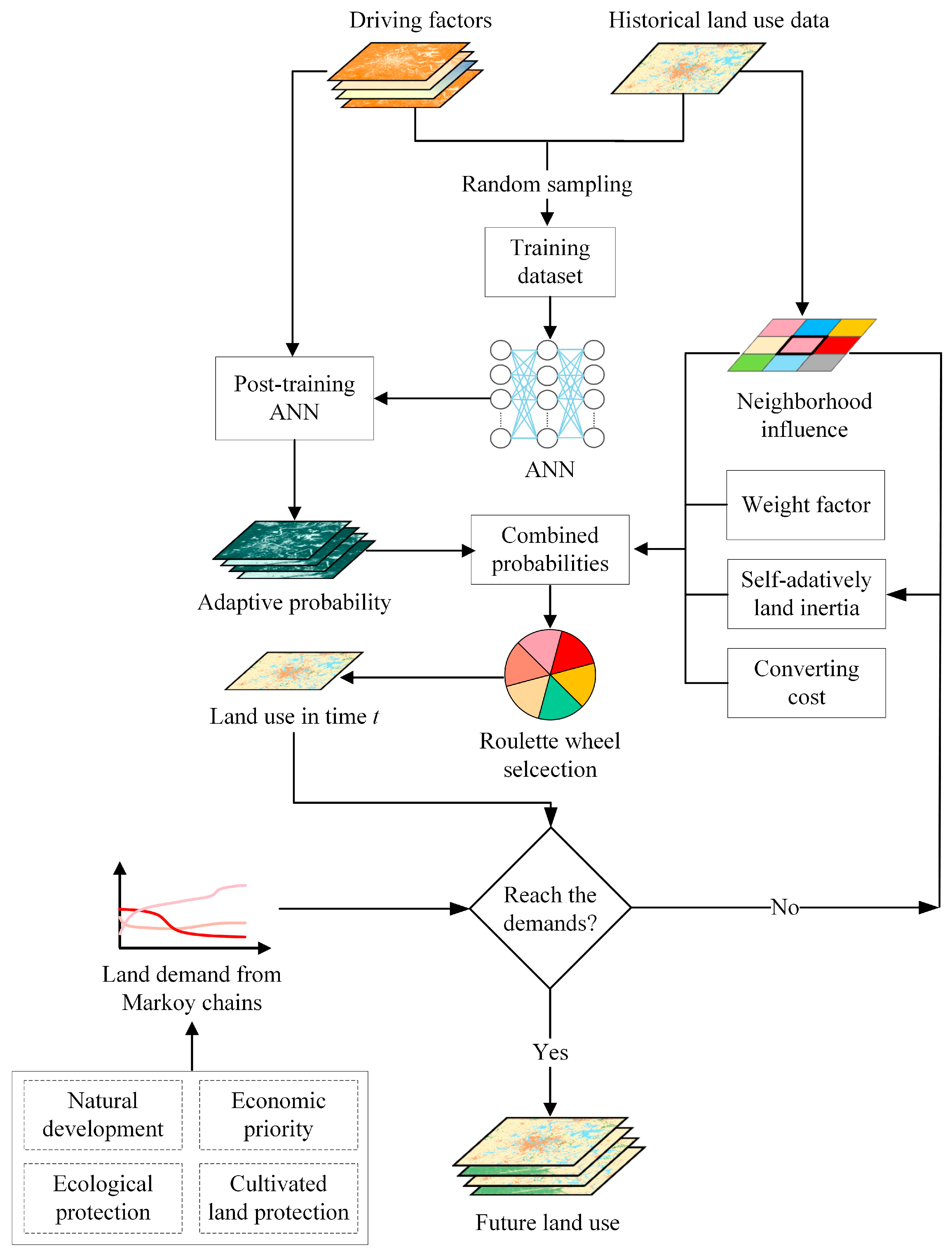
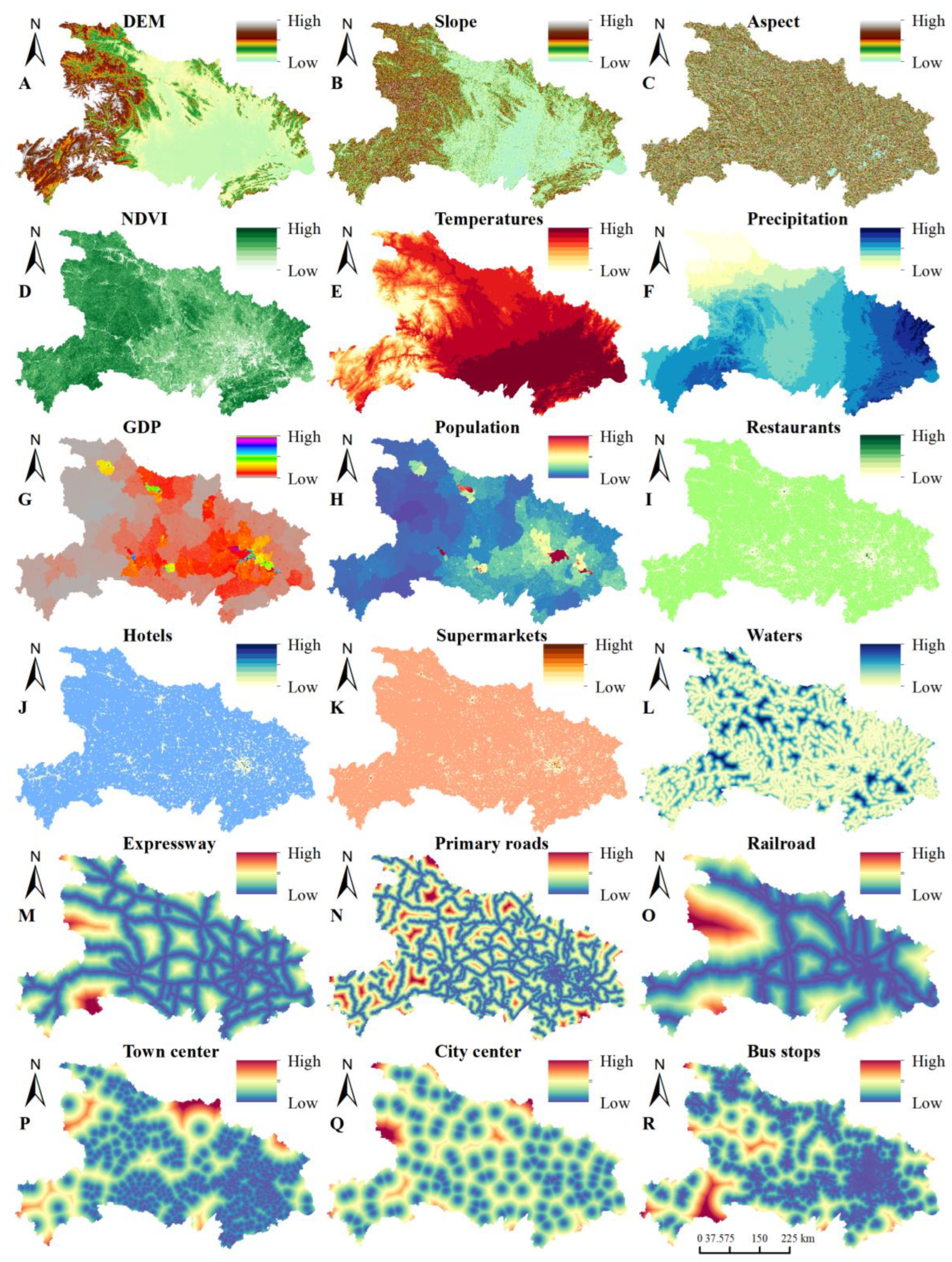
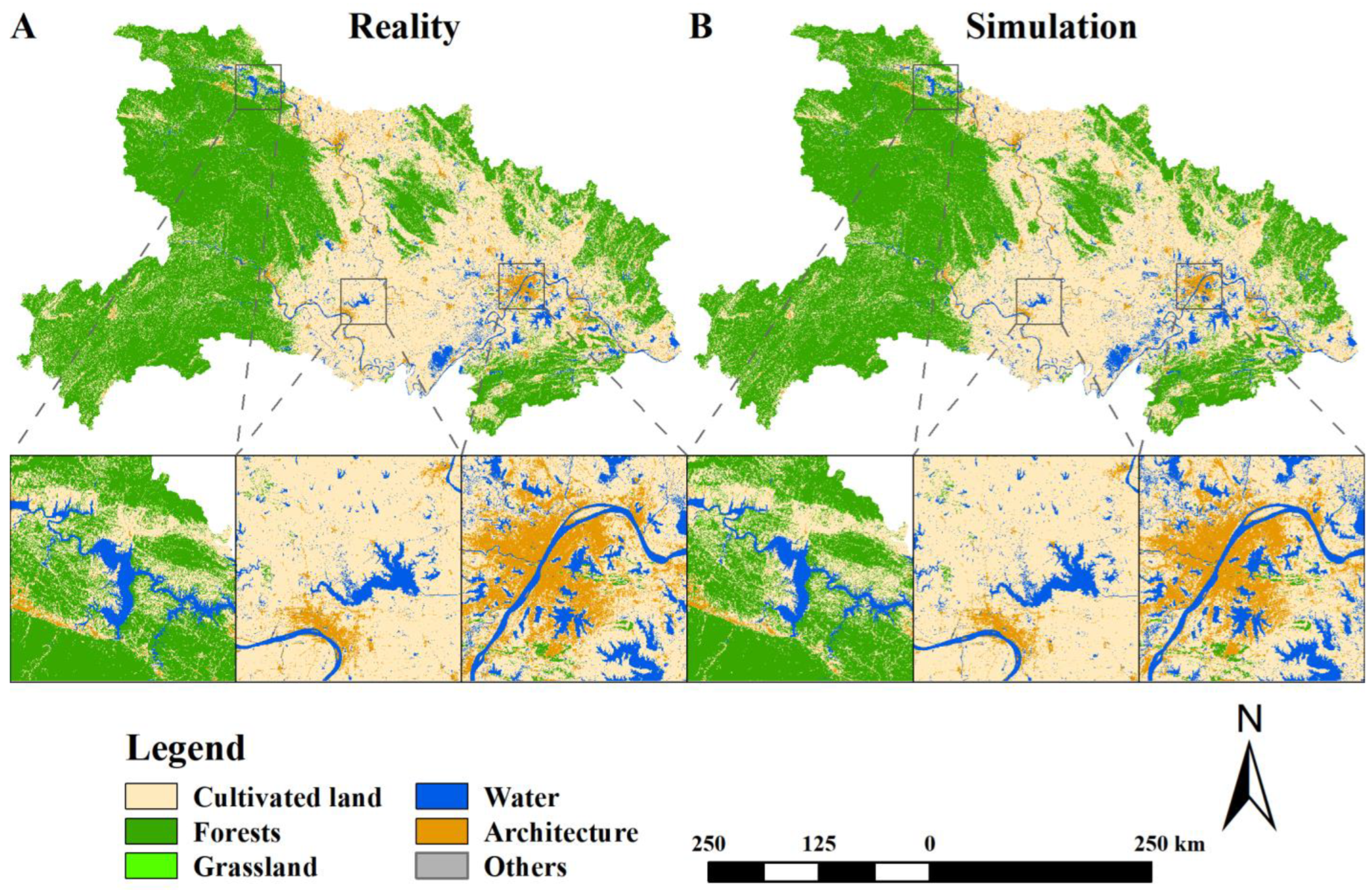
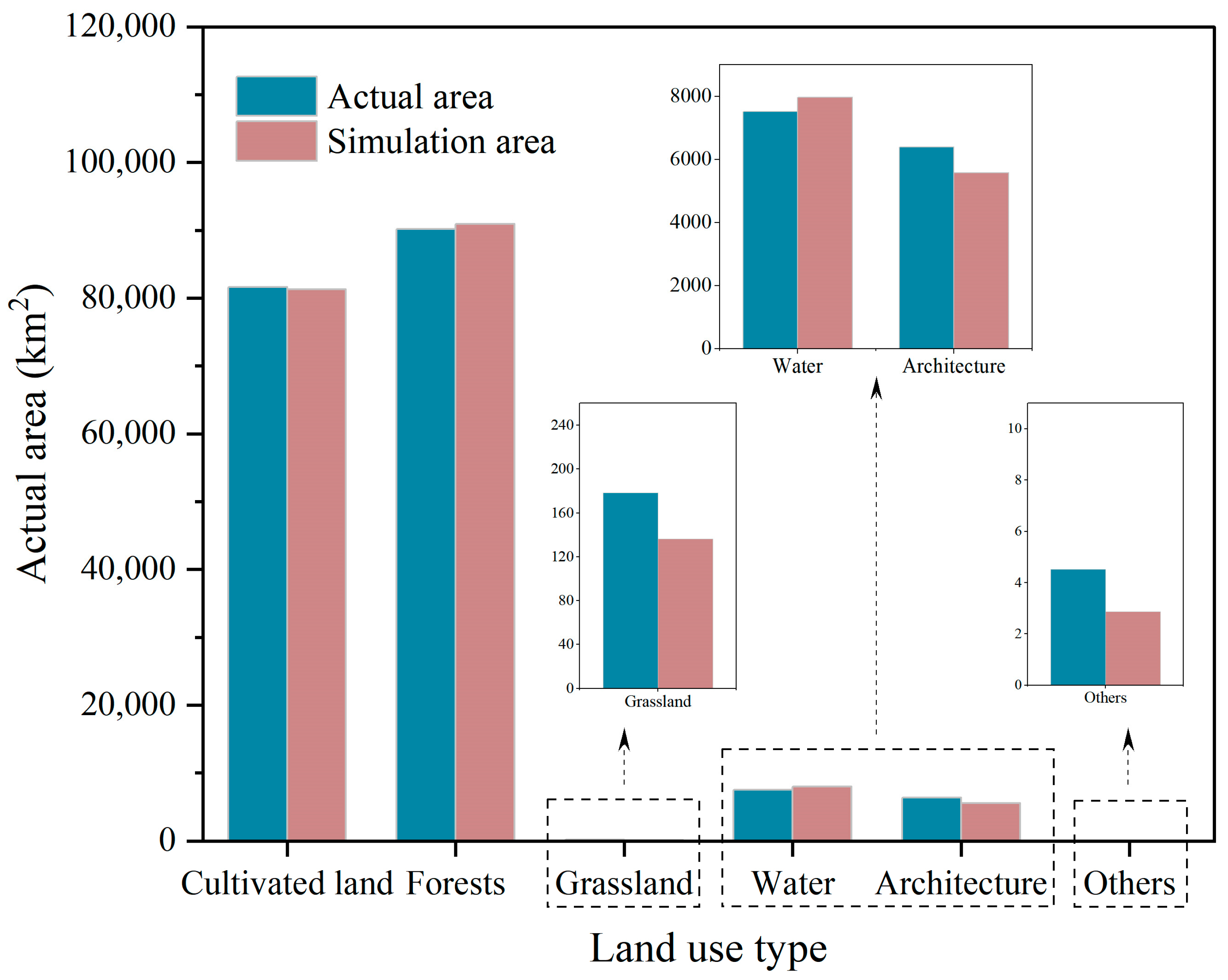
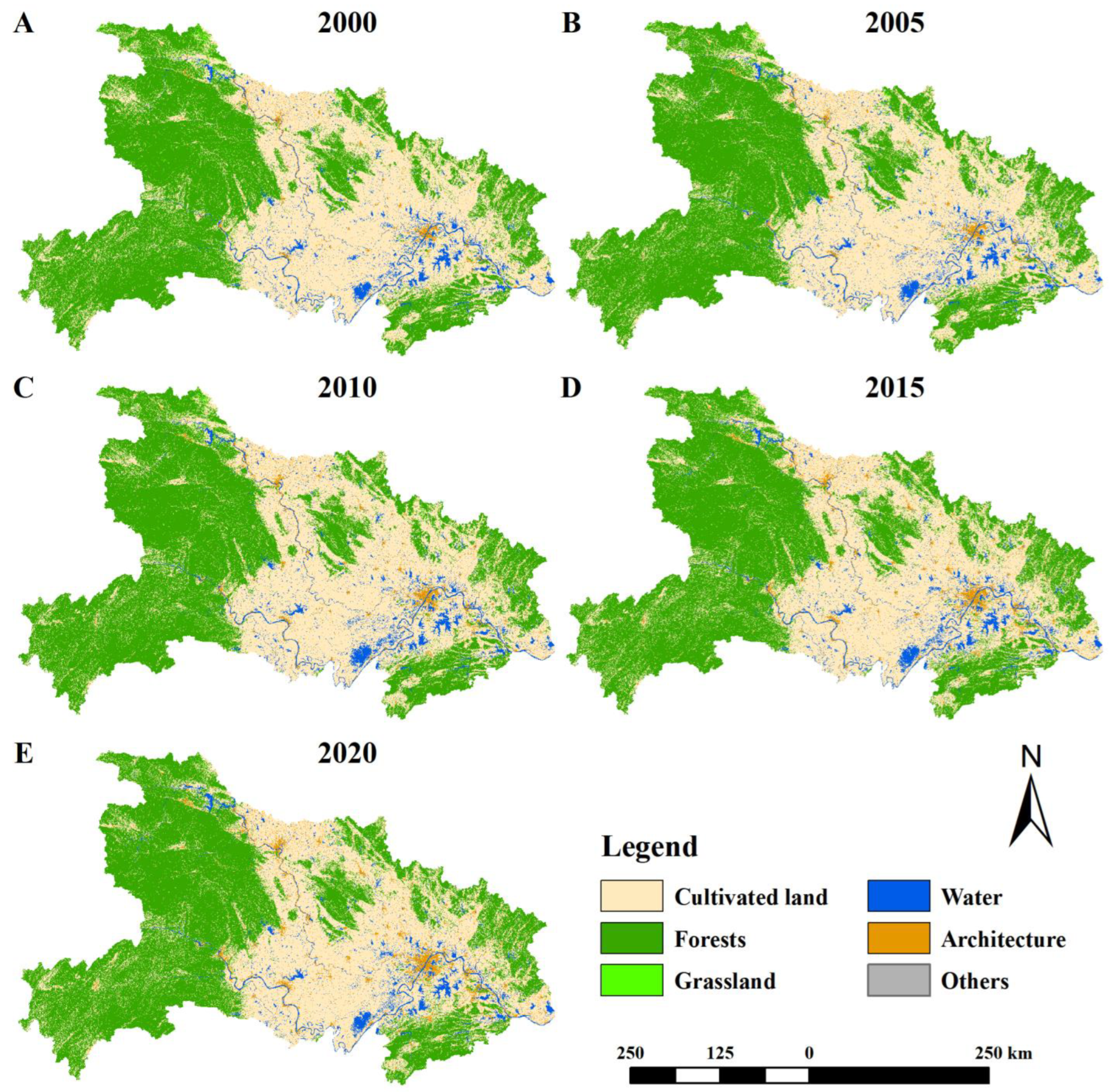
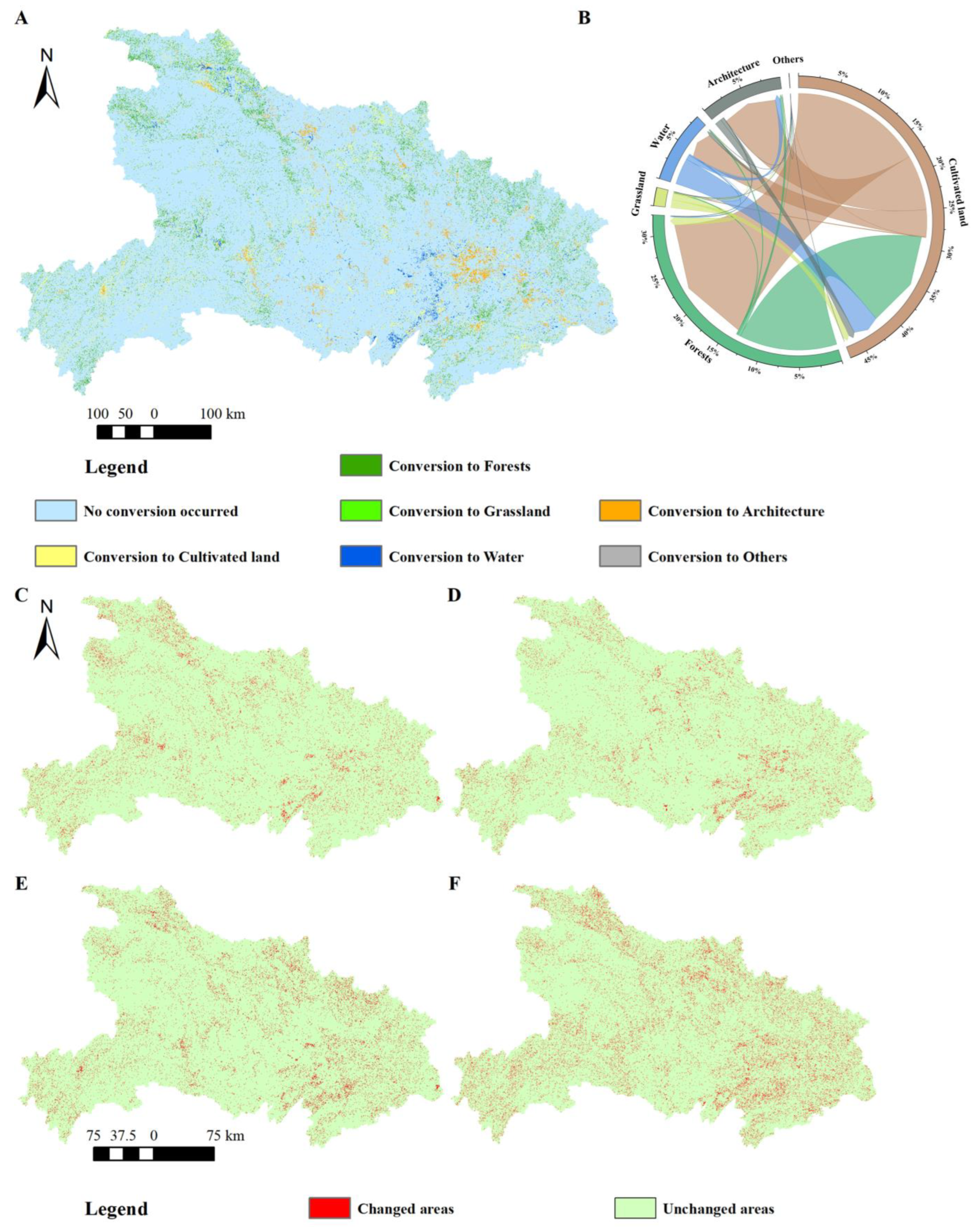
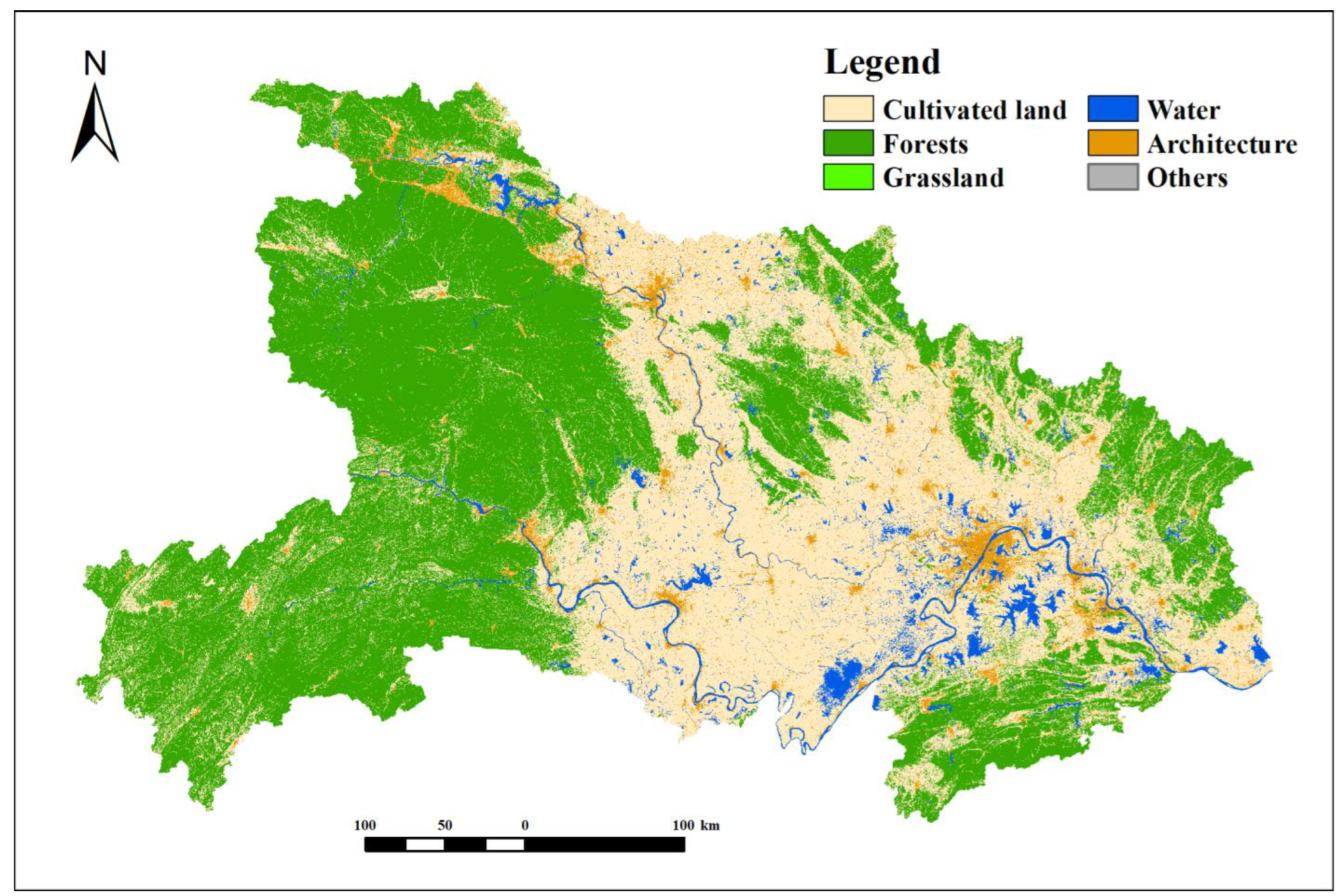
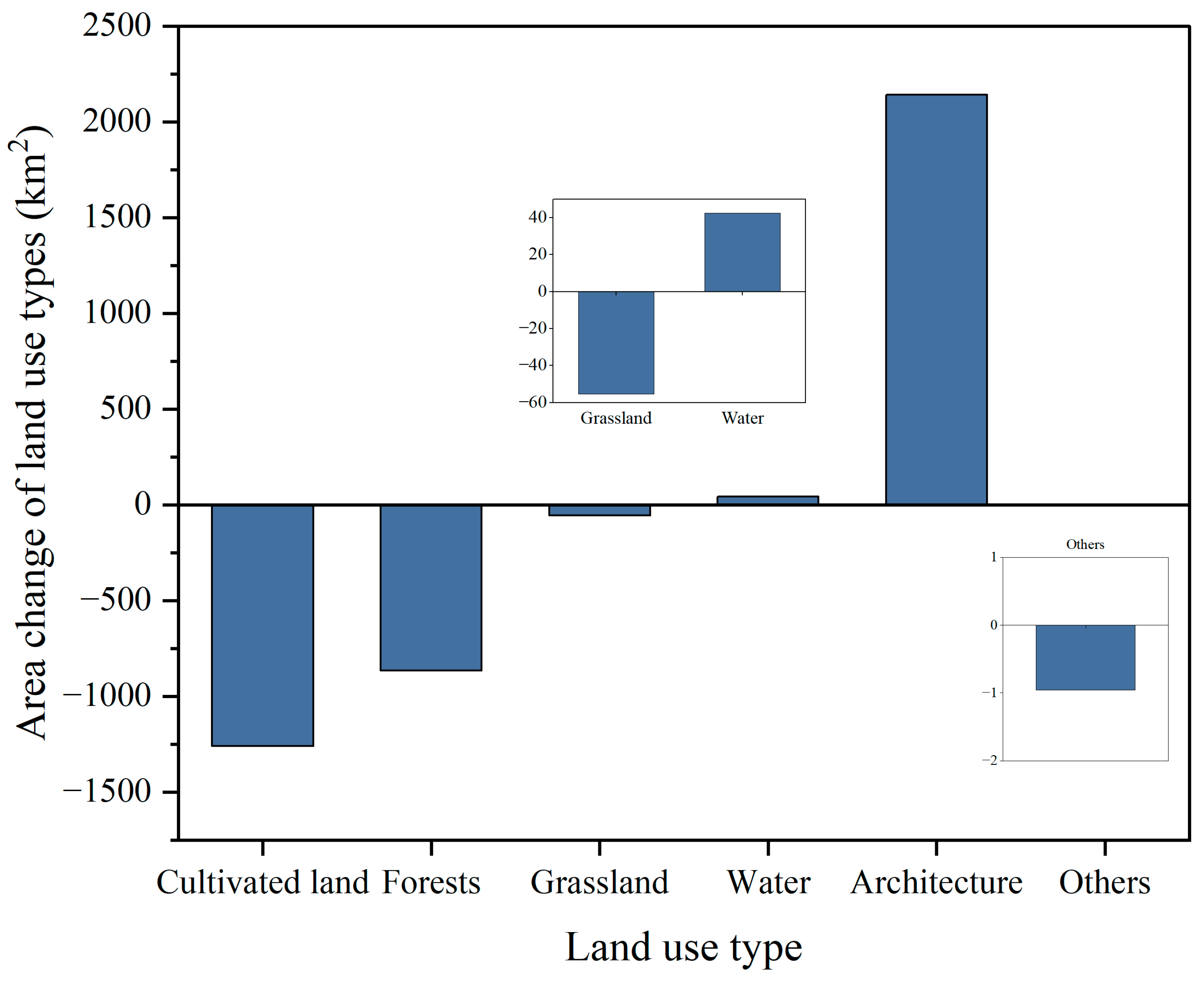
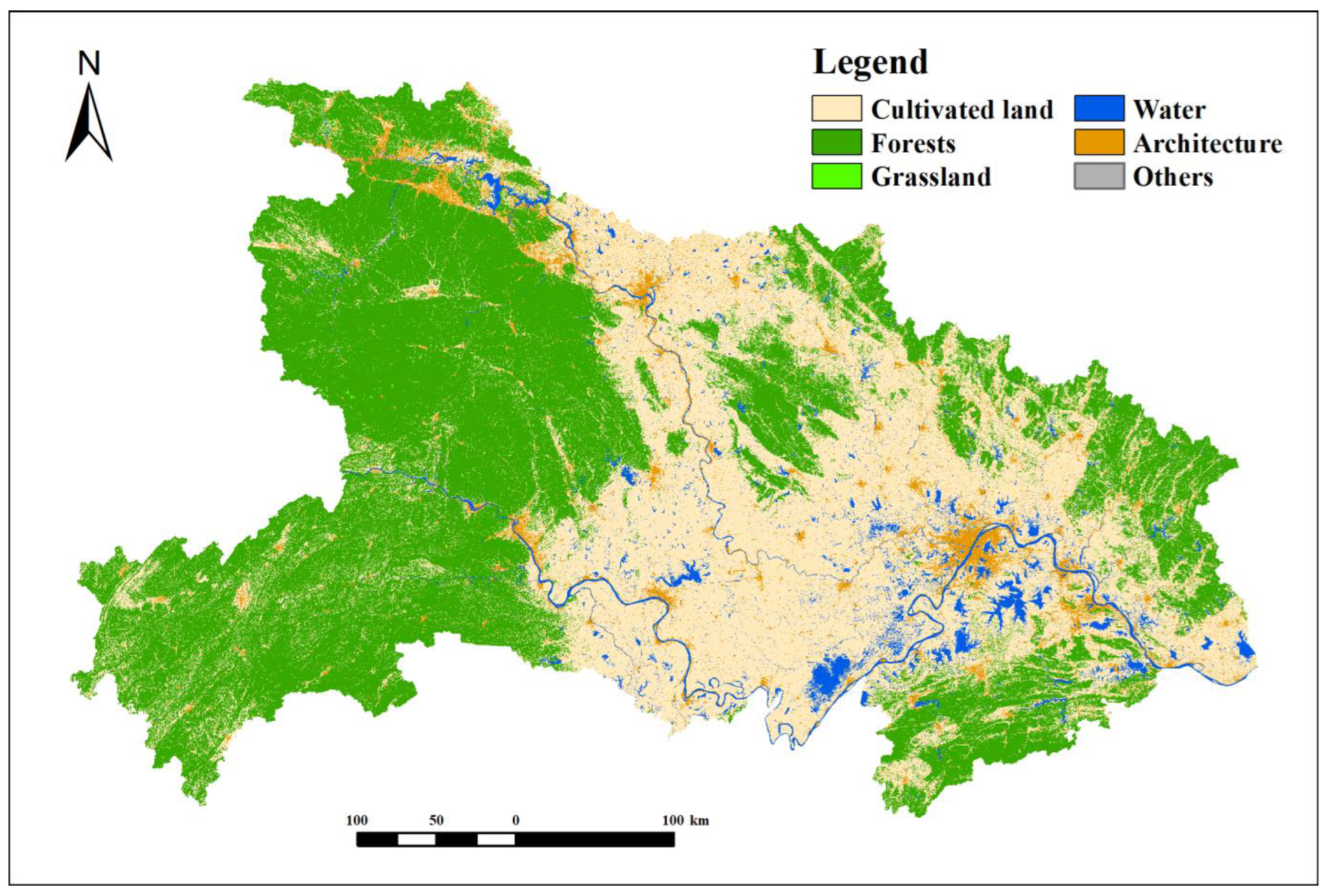
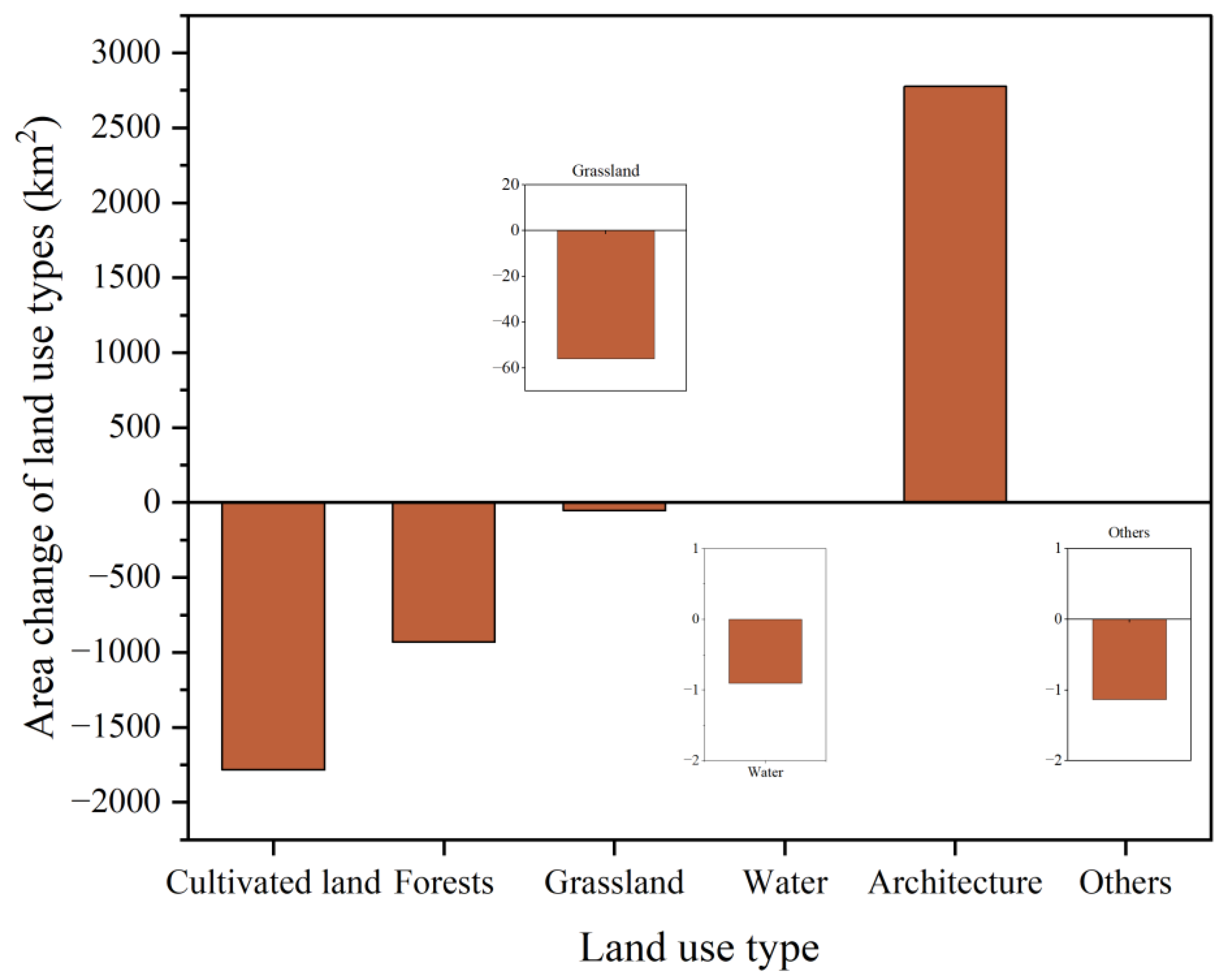
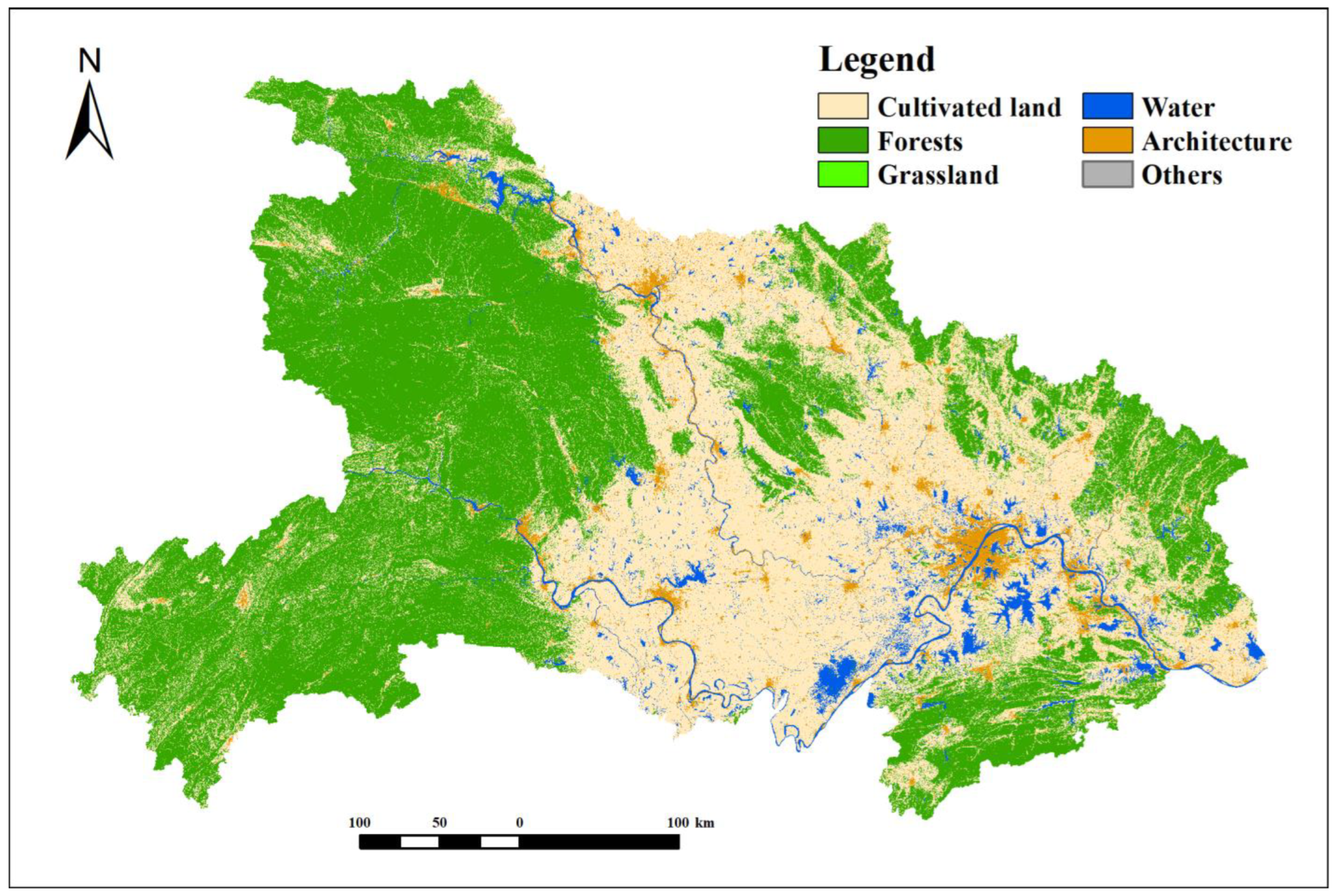
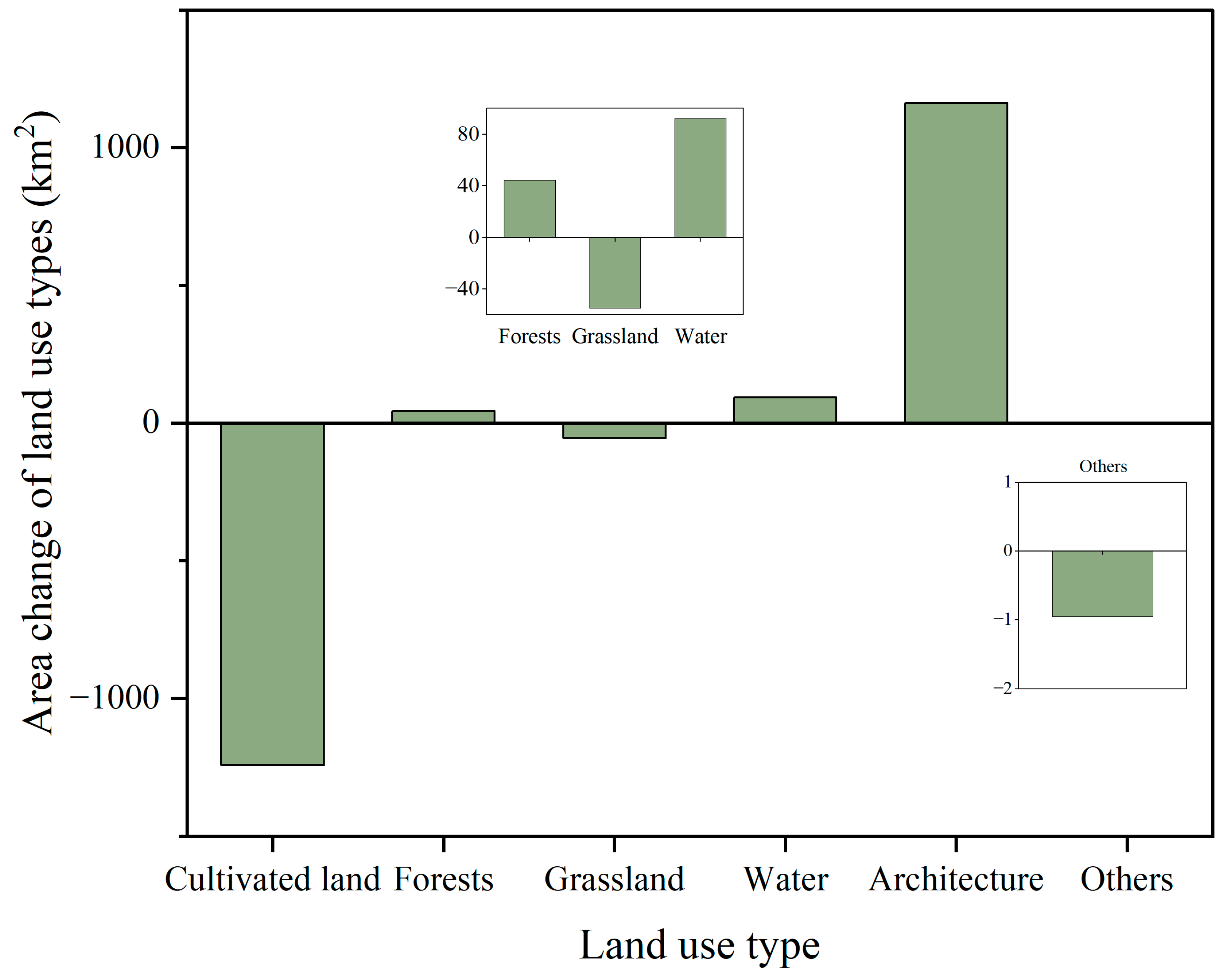
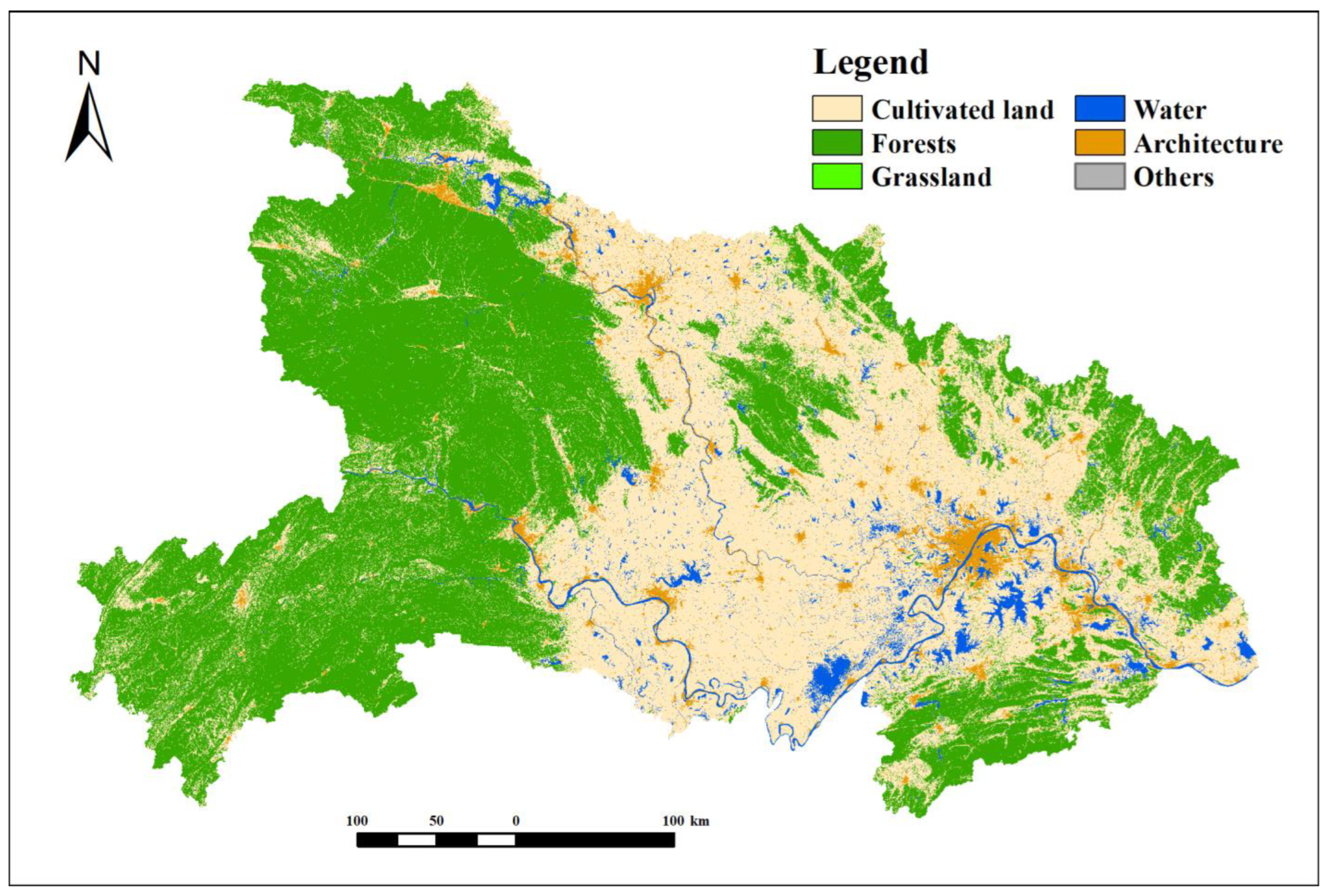
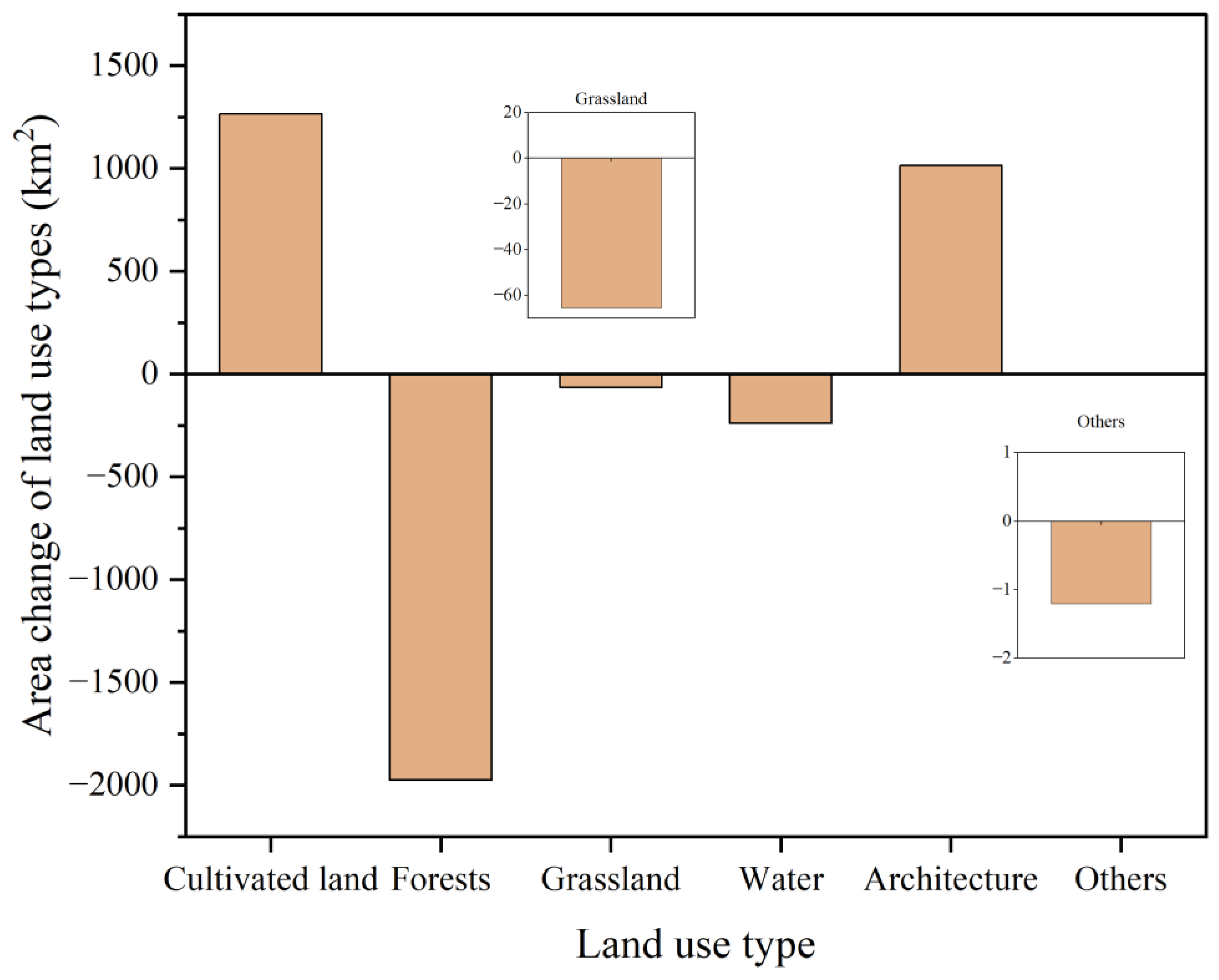
| Types | Driving Factors | Data Sources |
|---|---|---|
| Geographical factors | DEM | Geospatial Data Cloud (https://www.gscloud.cn/) |
| Slope | Geospatial Data Cloud ArcMap slope | |
| Aspect | Geospatial Data Cloud ArcMap aspect | |
| NDVI | Geospatial Data Cloud | |
| Climatic factors | Average temperature | The National Tibetan Plateau Data Center (https://data.tpdc.ac.cn/) |
| Average precipitation | The National Tibetan Plateau Data Center | |
| Socioeconomic factors | Population density | Resource and Environment Science and Data Center (https://www.resdc.cn/) |
| GDP | China National Bureau of Statistics (http://www.stats.gov.cn/) | |
| Restaurant distribution density | Resource and Environment Science and Data Center ArcMap Kernel Density | |
| Hotel distribution density | Resource and Environment Science and Data Center ArcMap Kernel Density | |
| Supermarket distribution density | Resource and Environment Science and Data Center ArcMap Kernel Density | |
| Location factors | Distance to waters | OpenStreetMap (https://www.openstreetmap.org) ArcMap European distance tool |
| Distance to expressway | OpenStreetMap ArcMap European distance tool | |
| Distance to primary roads | OpenStreetMap ArcMap European distance tool | |
| Distance to railroad | OpenStreetMap ArcMap European distance tool | |
| Distance to town center | OpenStreetMap ArcMap European distance tool | |
| Distance to city center | OpenStreetMap ArcMap European distance tool | |
| Distance to bus stops | OpenStreetMap ArcMap European distance tool |
| Inspection | OA | Kappa | FOM |
|---|---|---|---|
| Results | 0.93 | 0.85 | 0.139 |
| Land Use Type | Commission Error | Omission Error | Producer’s Accuracy | User’s Accuracy |
|---|---|---|---|---|
| Cultivated land | 0.0750608 | 0.0785903 | 0.92141 | 0.924939 |
| Forest | 0.0511676 | 0.0434008 | 0.956599 | 0.948832 |
| Grassland | 0.681315 | 0.756484 | 0.243516 | 0.318685 |
| Water | 0.17362 | 0.126522 | 0.873478 | 0.82638 |
| Architecture | 0.140058 | 0.248898 | 0.751102 | 0.859942 |
| Others | 0.683333 | 0.788889 | 0.211111 | 0.316667 |
| Scenarios | Cultivated Land | Forest | Grassland | Water | Architecture | Others |
|---|---|---|---|---|---|---|
| Natural development | 0.5 | 0.7 | 0.3 | 0.4 | 1 | 0.01 |
| Economic priority | 0.2 | 0.3 | 0.2 | 0.3 | 1 | 0.01 |
| Ecological protection | 0.3 | 1 | 0.7 | 0.5 | 0.8 | 0.01 |
| Cultivated land protection | 0.8 | 0.5 | 0.3 | 0.5 | 0.8 | 0.01 |
| Scenarios | Land Use Type | Cultivated Land | Forest | Grassland | Water | Architecture | Others |
|---|---|---|---|---|---|---|---|
| Natural development | Cultivated land | 1 | 1 | 1 | 1 | 1 | 1 |
| Forest | 1 | 1 | 1 | 1 | 1 | 1 | |
| Grassland | 1 | 1 | 1 | 1 | 1 | 1 | |
| Water | 1 | 1 | 1 | 1 | 1 | 1 | |
| Architecture | 1 | 1 | 1 | 1 | 1 | 1 | |
| Others | 1 | 1 | 1 | 1 | 1 | 1 | |
| Economic priority | Cultivated land | 1 | 1 | 1 | 1 | 0 | 1 |
| Forest | 1 | 1 | 1 | 1 | 0 | 1 | |
| Grassland | 1 | 1 | 1 | 1 | 0 | 1 | |
| Water | 1 | 1 | 1 | 1 | 0 | 1 | |
| Architecture | 1 | 1 | 1 | 1 | 1 | 1 | |
| Others | 1 | 1 | 1 | 1 | 1 | 1 | |
| Ecological protection | Cultivated land | 1 | 0 | 0 | 0 | 1 | 1 |
| Forest | 1 | 1 | 1 | 1 | 1 | 1 | |
| Grassland | 1 | 1 | 1 | 1 | 1 | 1 | |
| Water | 1 | 1 | 1 | 1 | 1 | 1 | |
| Architecture | 0 | 0 | 0 | 0 | 1 | 0 | |
| Others | 0 | 0 | 0 | 0 | 1 | 1 | |
| Cultivated land protection | Cultivated land | 1 | 1 | 1 | 1 | 1 | 1 |
| Forest | 0 | 1 | 1 | 1 | 1 | 1 | |
| Grassland | 0 | 1 | 1 | 1 | 1 | 1 | |
| Water | 0 | 1 | 1 | 1 | 1 | 1 | |
| Architecture | 0 | 1 | 1 | 1 | 1 | 1 | |
| Others | 1 | 1 | 1 | 1 | 1 | 1 |
Disclaimer/Publisher’s Note: The statements, opinions and data contained in all publications are solely those of the individual author(s) and contributor(s) and not of MDPI and/or the editor(s). MDPI and/or the editor(s) disclaim responsibility for any injury to people or property resulting from any ideas, methods, instructions or products referred to in the content. |
© 2023 by the authors. Licensee MDPI, Basel, Switzerland. This article is an open access article distributed under the terms and conditions of the Creative Commons Attribution (CC BY) license (https://creativecommons.org/licenses/by/4.0/).
Share and Cite
Zhu, K.; Cheng, Y.; Zang, W.; Zhou, Q.; El Archi, Y.; Mousazadeh, H.; Kabil, M.; Csobán, K.; Dávid, L.D. Multiscenario Simulation of Land-Use Change in Hubei Province, China Based on the Markov-FLUS Model. Land 2023, 12, 744. https://doi.org/10.3390/land12040744
Zhu K, Cheng Y, Zang W, Zhou Q, El Archi Y, Mousazadeh H, Kabil M, Csobán K, Dávid LD. Multiscenario Simulation of Land-Use Change in Hubei Province, China Based on the Markov-FLUS Model. Land. 2023; 12(4):744. https://doi.org/10.3390/land12040744
Chicago/Turabian StyleZhu, Kai, Yufeng Cheng, Weiye Zang, Quan Zhou, Youssef El Archi, Hossein Mousazadeh, Moaaz Kabil, Katalin Csobán, and Lóránt Dénes Dávid. 2023. "Multiscenario Simulation of Land-Use Change in Hubei Province, China Based on the Markov-FLUS Model" Land 12, no. 4: 744. https://doi.org/10.3390/land12040744
APA StyleZhu, K., Cheng, Y., Zang, W., Zhou, Q., El Archi, Y., Mousazadeh, H., Kabil, M., Csobán, K., & Dávid, L. D. (2023). Multiscenario Simulation of Land-Use Change in Hubei Province, China Based on the Markov-FLUS Model. Land, 12(4), 744. https://doi.org/10.3390/land12040744













